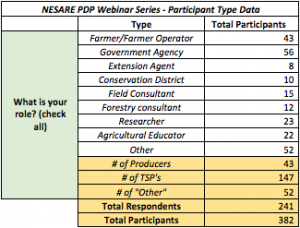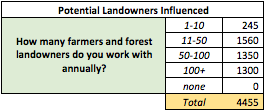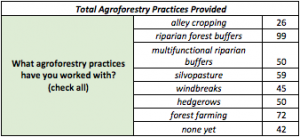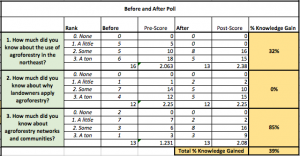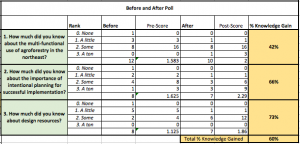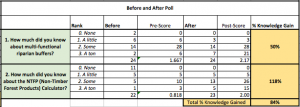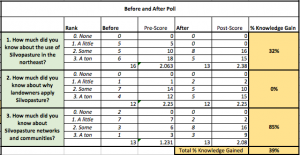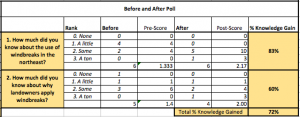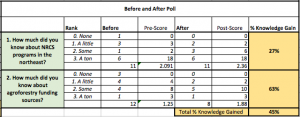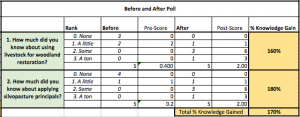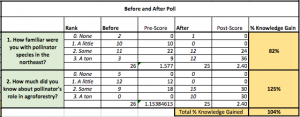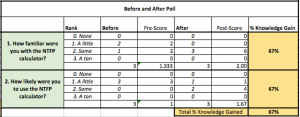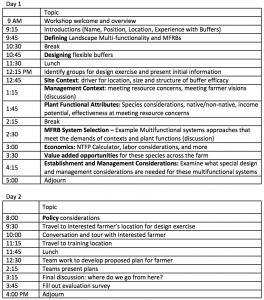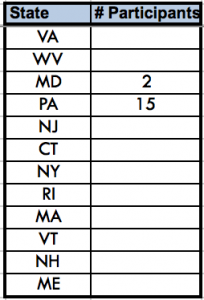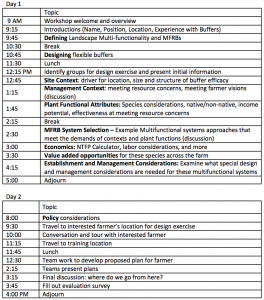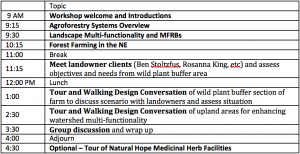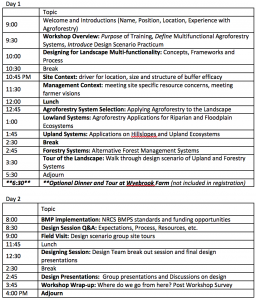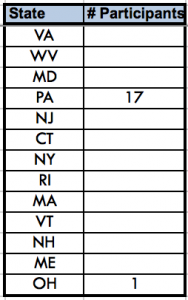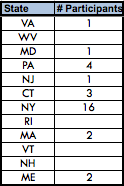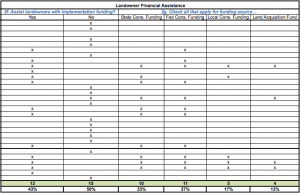Final report for ENE15-134
Project Information
The need for the NESARE funded project NE Advanced Agroforestry Training for Natural Resource and Agricultural Educators was identified through of a case study (Strong and Jacobson, 2006) and a collaborative effort among agency, academic and NGO staffs. This case study was designed to measure agroforestry adoption potential among forest and agricultural landowners and concluded that most study participants felt that they did not have enough information regarding implementation, management and marketing to adopt agroforestry. The study suggested that forestry and agriculture educators should begin to build a multidisciplinary and collaborative agroforestry team to address stakeholder needs. Additionally, in 2014, a team of state, federal, academic and non-governmental organizations convened to build support for adoption of agroforestry systems within the Chesapeake Bay region. During facilitated discussion, the group identified these goals that informed the objectives of this project:
- Increase numbers of agroforestry practitioners
- Create a clearinghouse for regional agroforestry information
- Build networks among disciplines
- Develop a consistent presence with ability to respond to farmer’s and landowner’s requests
- Train-the-trainer workshops that target resource professionals in the watershed as a first step toward reaching watershed landowners.
The need for the NESARE funded project NE Advanced Agroforestry Training for Natural Resource and Agricultural Educators was identified through of a case study (Strong and Jacobson, 2006) and a collaborative effort among agency, academic and NGO staffs. This case study was designed to measure agroforestry adoption potential among forest and agricultural landowners and concluded that most study participants felt that they did not have enough information regarding implementation, management and marketing to adopt agroforestry. The study suggested that forestry and agriculture educators should begin to build a multidisciplinary and collaborative agroforestry team to address stakeholder needs. Additionally, in 2014, a team of state, federal, academic and non-governmental organizations convened to build support for adoption of agroforestry systems within the Chesapeake Bay region. During facilitated discussion, the group identified these goals that informed the objectives of this project:
Increase numbers of agroforestry practitioners
Create a clearinghouse for regional agroforestry information Build networks among disciplines
Develop a consistent presence with ability to respond to farmer’s and landowner’s requests
Train-the-trainer workshops that target resource professionals in the watershed as a first step toward reaching watershed landowners.
To meet these identified needs, this project provided agroforestry training through two 3-day workshops, three 2-day workshops, three 1-day workshops and 13 webinars. Three hundred eighty-three individuals (383) participated in the webinars; 147 service providers, 43 farmers and the remaining not reporting an affiliation; participants at all workshops totaled 88 service providers, 37 farmers and 35 of unspecified affiliation. Training topics covered all aspects of agroforestry practices including riparian buffers, multi-functional buffers for livestock farms and grazing in buffers; silvopasture; non-timber forest products including chestnuts and botanical; windbreaks, and principles for designing agroforestry practices on farms. Workshops included farm tours and opportunities for participants to evaluate sites for agroforesty practices and develop agroforestry designs using aerial images.
Webinar and workshop participants received post-event surveys to assess their learning, obtain demographic information, and for service providers, obtain an estimate of the number of farmers and other landowners they routinely worked with who may practice or have interest to practice agroforestry. 198 webinar participants and 89 workshop participants responded to the post-training surveys. Webinar respondents reported an average 77% gain in knowledge and workshop respondents indicated an overall 44% gain in knowledge because of the trainings. Higher gains in knowledge were reported for some individual topics,
Service providers responding to the post-event surveys reported they worked with an estimated 3,619 landowners, many of whom are farmers, who manage an estimated 239,940 acres. Further, they reported that an estimated 1,425 of the landowners they work with are already practicing one or more agroforestry practices and 2,194 have interest in these practices. This data provides a strong indication that the potential is high that this program has had influence on decisions by farmers and other forest landowners advised by project participants.
Three additional grants were awarded that were directly related to this Northeast SARE funded project. Two of the three were related to seeking chestnut aggregation and cooperative development through the Northeast SARE Farmer Grant and the PA Specialty Crop Block Program. The third grant is related to silvopasture developments in New England that have been direct cooperators within the administration of this funded project. In addition, the educational opportunities provided in the grant enhanced the outreach and application of multi-functional buffer program administered by the PA Department of Conservation and Natural resources program.
One of the greatest successes of this project was the development of the Northeast Mid-Atlantic Agroforestry (NEMA) Network. What started as the advisory board for this project and members from the Association for Temperate Agroforestry working groups, has become a region-wide network of technical service providers, researchers educators and practitioners convening around support for the development of agoforestry systems in the northeast and mid-Atlantic regions. Continued quarterly calls, website and social media presence and continued webinar series are all tangible outcomes of this project. This networks is currently seeking to implement non-profit status in order to administer their own funding resources and programmatic activities through collaborative outreach and educational opportunities across state and institutional boundaries.
40 Northeast service providers who receive comprehensive agroforestry training will provide agroforestry assistance to 120 farmers and graziers who manage 3,600 acres of woodlot.
Natural resource educators, including agency, NGO, early adopters, peer-to-peer volunteer networks, and extension staffs were the primary project beneficiaries. These trainees helped to form the foundation of a regional community of educators that, is continuing to provide advice and information to farmers though ongoing webinars and collaboration among participants. This expanding pool of producers and service providers who are comfortable with agroforestry practices and design are continuing to facilitate knowledge transfer and land steward adoption of agroforestry. The cascading effects of enhancing economic and ecological diversity and are increasing resiliency and sustainability of rural and urban forest and agricultural communities and food systems.
Cooperators
Educational Approach
The educational approach was to first present agroforestry principles, practices, and examples, followed by a farm tour, where practical. Participants were then separated into groups to design agroforestry systems using aerial images of a farm. This collaborative approach provided participants with networking and peer-to-peer educational opportunities since participants came from a variety of disciplines and levels of experience. Over time, participants have continued to engage both with the presenters and with their fellow attendees. These interactions are crucial to one of the goals of this project: to create a community of agroforestry practitioners in the NE who would then work with farmers.
Webinars were an additional educational tool. Thirteen agroforestry webinars were held between 2016 and 2017 and are archived here http://www.nemaagroforestry.org/webinar-archive-2016-2017. The United States Forest Service, National Agroforestry Center provided funding for an additional 12 webinars to be held 2018-2019. Incorporating webinars as educational tools allowed project coordinators to enlist practitioners and researchers across the country to present topics of value to NE providers and farmers at relative low cost and enhanced convenience to participants.
Milestones
1. 400 service providers and 300 farmers are invited to Agroforestry webinars
January 2016
2. 100 providers and 40 farmers participate in webinars and are introduced to agroforestry, 80 respond to survey at end of introductory webinar to identify interests and gaps in education
40
100
43
147
February 29, 2016
Completed
December 07, 2018
Supporting Materials:
Accomplishments
Outreach:
“Agroforestry in Focus” -- New column in Penn State Sustainable Ag News
In January 2016, team members Erik Hagan and Tracey Coulter met with Charlie White, erstwhile PA SARE coordinator and extension specialist, to develop a new column in the Penn State Sustainable Ag News highlighting this NE- SARE PDP project and agroforestry opportunities in the NE. The inaugural article appeared in the March 2016 issue and was entitled: Agroforestry for the Northeast: New Project to Develop Regionally Appropriate Training Materials: http://extension.psu.edu/plants/sustainable/news/2016/spring-2016/agroforestry-for-the-northeast . Other quarterly articles featured the Rt. 9 Chestnut Co-op in Carrollton, Ohio that Greg Miller presented at the September agroforestry training and an overview of that Biglerville training.
Northeast/Mid-Atlantic Agroforestry (NEMA) Working Group
The Northeast/Mid-Atlantic Agroforestry (NEMA) Working Group formed in late 2015 and is a consortium of researchers, technical service providers, governmental agencies, practitioners and experts focused on educating, promoting and implementing agroforestry systems in the Northeast and Mid-Atlantic Region of North America. This NE SARE – funded project was a central focus of the team.
In the summer of 2016, Interns working for the PA Department of Conservation and Natural Resources enhanced the new NEMA website : www.nemaagroforestry.org and the NEMA Facebook Page www.facebook.com/NEMAAgroforestry by adding content and creating a logo for the group to use in promotional materials.
Webinar Milestones:
The first three webinars have attracted 89 participants from across the Northeast with even representation from across Europe, with each presentation attracting more participants. One challenge we are having with webinar polls is user participation. We have developed pre webinar questionnaires as well as pre and post webinar polls to determine learning efficacy. Though user participation in the pre and post webinar poll is low, we are still able to garner useful information. Of those that have participated in the pre webinar questionnaire the following outlines data on participant type, leading to our milestone goal.
Thus, out of 52 respondents: 30 can be directly considered professional service providers; 10 producers, and 12 from professions not clarified. These numbers do not reflect the entire participant pool, however, as these solely reflect those that participating in the pre-webinar survey. Additionally, the webinars are archived and posted on the project website for post webinar broadcast viewing. These views are tracked through the Penn State webinar classroom system. As of December 31st, 2016, 134 viewers watched the October webinar and 149 additional viewers watched the November webinar. December’s webinar has just recently been posted to the website with no data yet available.
The attached document “NEMA Webinar Reporting_Final” demonstrates participant representation and learning advancements in detail, which will be compiled and better represented towards our Performance Target in this final report. The following tables provide insight into the learning objectives verified in terms of percent knowledge gain of the entire participating ground:
The NESARE PDP sponsored NEMA Webinar series has been highly successful. Starting in 2016 and continuing currently through 2019 with additional funding allocated through the US Forest Service National Agroforestry Center. This additional funding source will expire in August of 2019, and the webinar series will be continued through Cornell Cooperative Extension’s Small Farm Program indefinitely.
The webinar series reported here consisted of 13 webinars, which reached a total of 382 participants. Of these 382 participants, 241 responded to post-webinar polls for data collection; 43 indicated they were farmers, 147 were classified themselves as technical service providers and 52 classified themselves as “other.”
Within each poll data was collected to understand how many landowners each participant worked with on an annual basis in order to better understand our impact within the agricultural community. An estimated 4,455 landowners are feasibly influenced by the information presented through these 13 webinars.
Additionally, participants were asked which agroforestry practices they currently have experience with to better understand the gaps in agroforestry knowledge as well as the wealth of experiences participants engaged in the region. From this data, alley cropping (26 participants) and windbreaks (45 participants) are the practices that fewest respondents have experience with; riparian buffers (99 participants), though not multifunctional riparian buffers (50 participants) and forest farming (72 participants) are the most applied agroforestry practices in the NEMA region. Thus, alley cropping and windbreaks are areas within the NEMA region with a demonstrated need for additional resources and educational materials. Additionally, only 42 of the participants responded to not having any experience working within an agroforestry specific practice, indicating a reasonably high level of familiarity with agroforestry practices and a clear need for more advanced agroforestry system resources and educational materials to support the growing community.
As will be demonstrated below ,the polls also consisted of 1-3 questions to help determine a percent gain in knowledge from the webinar presentations. We are excited to present that there was a clear 74% increase in knowledge over the course of the reported 13 webinars. This increase in knowledge will be detailed further within the description of each webinar below.
WEBINAR #1: Agroforestry Opportunities and Resources in the Northeast – Kate MacFarland
Kate MacFarland from the USDA National Agroforestry Center provided an introductory look into agroforestry systems in the northeast and the natural resource concerns they can help address. The webinar examined agroforestry’s economic benefits and provided examples of producers using agroforestry practices in the region. Finally, Kate shared resources for learning more about agroforestry in the region, including training activities with the Northeast Advanced Agroforestry Training for Natural Resource and Agricultural Educators project, funded by Northeast SARE.
During this first in the NEMA webinar series, 27 participants joined, of which 8 were producers and 12 were technical service providers. As demonstrated below, there was a total of 39% increase in awareness on agroforestry opportunities in the Northeast/Mid-Atlantic region. The greatest increase in awareness (85%) demonstrated by the polls suggest the increase in understanding of the vast agroforestry networks and communities that exist across the region. Since this was an introductory webinar on the NESARE Professional Development Training program in general, there was not clarity gained on how to apply agroforestry systems, but there was a 32% increase in understanding that the opportunity does exist in the region.
WEBINAR #2: Design and Planning for Multifunctional Agroforestry Systems – Erik Hagan
Planning and design are critical first steps when adding agroforestry practices on the farm or in the woods. Landowner goals, landscape position, species selection, and many other key factors are crucial to successful implementation. The second installment of the NEMA Agroforestry Webinar Series, with Erik Hagan, a graduate student at Penn State and a researcher with the USDA Agricultural Research Service. provided an introductory look into design principles and resources for enhancing participants' clients or their own operations’ success in incorporating perennial systems. Erik also shared resources for learning more about agroforestry design through continuing training activities with the Northeast Advanced Agroforestry Training for Natural Resource and Agricultural Educators project, funded by Northeast SARE.
During the second monthly webinar, 28 participants joined the presentation, of which only 8 responded to the poll. 4 of the participants classified themselves as technical service providers and 8 reported themselves as “other.” In total there was an average of 60% total gain in knowledge from the polled participants on design and planning for agroforestry systems. The greatest knowledge gain was in design resources (73% increase) and the importance of intentional design in developing agroforestry systems (66% increase). There was only a 42% gain in knowledge on the concept of multi-functionality in agroforestry systems.
WEBINAR #3: Multifunctional Riparian Buffer and the NTFP Calculator – Katie Commender and Emily Lachniet
Traditional riparian forest buffers help protect our waterways by reducing agricultural run-off and soil loss while also providing shade and woody debris to enhance wildlife habitat. Multi-functional riparian buffers build on this idea by also allowing landowners to grow a perennial food crop in the buffer zone. The third installment of the NEMA Agroforestry Webinar Series, with Emily Lachniet and Katie Commender of Appalachian Sustainable Development (ASD) shared ASD’s work with an NRCS Conservation Innovation Grant project that was nearing completion. The project’s aim was to promote these types of buffers in Southwest Virginia by establishing on-the-ground demonstration buffers and developing outreach materials and tools. Emily shared lessons learned about buffer design, species and cultivar selection, and landowner participation highlighting several case studies from the project. Katie introduced us to the Non-Timber Forest Products (NTFP) Calculator. This Microsoft Excel-based tool provides general estimates of income potential from harvesting and selling non-timber forest products from a conservation planting.
During this third installment in the NEMA webinar series, 34 participants joined, of which 14 were producers and 2 were technical service providers and 5 classified themselves as others that participated in the post webinar poll. As demonstrated below, there was a total of 84% increase in awareness in multifunctional buffers and planning resources, with 118% increase in awareness on the NTFP calculator and a 50% increase in understanding of multi-functional buffers.
WEBINAR #4: Silvopasture in the Northeast United States – Joe Orefice
The fourth webinar in our series focused entirely on Silvopasture in the Northeast. Silvopasture combines trees with forage and livestock production. In this webinar, Joe Orefice, Assistant Professor at Paul Smith’s College, discussed his work identifying and cataloging silvopasture practices that are most suitable and economically viable in the Northeastern United States. We also heard about his work on the development of: A Photo Guide to Northeastern US Silvopasture. This guide is the result of research investigating silvopasture practices on farms in New York and New England.
During this fourth installment in the NEMA webinar series, 29 participants joined the call and 23 completed the post-webinar poll. There was an average 39% total increase in awareness of silvopasture systems in the northeast. 85% of the increase in awareness concerned the community of silvopasture experts and a 32% increase in the use of silvopasture in the NE.
WEBINAR #5: American Chestnut Opportunities in the Northeast – Sara Fitsimmons
The American Chestnut Foundation’s (TACF) Director of Restoration,
Sara Fitzsimmons spoke with us about American Chestnut restoration opportunities in the Northeastern US for our fifth webinar in the series. TACF’s mission is to restore the American Chestnut tree to our eastern woodlands to benefit our environment, our wildlife, and our society. Sara presented the potential for American chestnuts to be incorporated into agroforestry systems to meet both economic and restoration goals.
During this webinar, 39 participants joined and 23 of which responded to the post- webinar poll where there was a demonstrated total increase of 76% awareness specifically about the restoration programming of the American Chestnut in the Northeast.
WEBINAR #6: Multi-functional Buffers for Poultry and Livestock Farms – Paul Patterson
Dr. Paul Patterson is a Professor of Poultry Science at The Pennsylvania State University. He spends 70 percent of his time concentrating on extension duties, particularly those dealing with laying hen management and nutrition. The other 30 percent he devotes to research involving poultry nutrition, egg production, handling and storage, and poultry waste, nutrient management and recycling. During this webinar, Paul discussed novel approaches to windbreak use in large scale poultry operations and the potential for air and water quality mitigation, carbon sequestration and feedstock for energy, bedding and additional livestock production needs. This research can transpose beyond confinement operations and be applied any most any scale and to most any livestock operation for multi-functional benefits.
During this webinar, 27 participants joined while 17 responded to post-webinar polls. Of these, 3 were producers, 12 were classified as technical service providers and 2 classified themselves as other. There was a demonstrated 72% average total increase in knowledge with 83% increase in knowledge about the use of windbreaks in the northeast and with a 60% increase in knowledge about why landowners would apply windbreaks.
WEBINAR #7: The Roots of Appalachia: Sourcing Native Appalachia Medicinal Forest Plants through Forest Farmers – Eric Burkhart
Eric Burkhart is a Faculty Instructor in the Ecosystem Science and Management Department at PSU and Plant Science Program Director at Shaver’s Creek Environmental Center. This webinar discussed how the adoption of forest-based medicinal plant cultivation could provide a mechanism for forest landowners in the eastern United States to generate income, conserve forestlands, while simultaneously addressing native medicinal plant conservation and identity/quality concerns. However, status quo market conditions favor wild exploitation making it difficult for any profitable transition to forest cultivated or stewarded sources. Quality and identity concerns, market pricing, and sustainability was discussed along with current efforts to provide consumers with sourcing assurances via a new forest botanical labeling network (‘forest grown’) that relies upon third-party inspections and verification.
During this webinar, 35 participants joined and 15 completed the post-webinar poll. There were 5 producers and 7 technical service providers that demonstrated a total of 67% increase in awareness on native medicinal plants to the Northeast.
WEBINAR #8: Agroforestry and NRCS Programs in the Northeast – Michael Fournier
Initially conservation practices can often be costly, with the promise of long-term financial benefits. Through USDA Farm Bill cost share programs, the Natural Resources Conservation Service (NRCS) can help private landowners invest in their land’s future. Michael covered NRCS’s current planning policy and procedures, agroforestry systems and conservation practice standards, and an explanation of how the program enrollment process works in NY State.
During this webinar, 23 participants joined and 18 completed the post-webinar poll. Of these, 3 producers and 13 technical service providers demonstrated a total of 45% increase in, with 63% increase concerning general agroforestry funding while 27% increase in understanding of NRCS involvement in the Northeast.
WEBINAR #9: Woodland Restoration Using Livestock and Silvopasture Principles – Brett Chedzoy
Studies by The Nature Conservancy, Cornell University and the NY State College of Environmental Science and Forestry (ESF) show deteriorating conditions in the majority of NY’s nearly 19 million acres of forest – a situation that is not unique to New York and the Northeast. Silvopasturing and intensively-managed livestock impacts are an innovative approach to address many of the modern challenges facing woodland owners and managers. Brett Chedzoy, MF, is a regional extension forester with Cornell Cooperative Extension of Schuyler County, and the Forest Manager of Cornell’s Arnot Teaching and Research Forest covered specific examples of how silvopasturing has been successfully used to rehabilitate degraded woodlands into profitable and productive forested landscapes that can sustained over time.
During this webinar, 12 participants joined and 11 of them completed the post-webinar poll. 1 producer and 9 technical service providers demonstrated a 170% increase in knowledge on woodland restoration and silvopasture principles.
WEBINAR #10: Applied Agroforestry Case Study: Wellspring Forest Farm and School – Steve Gabriel
Steve is Agroforestry Extension Specialist for the Cornell Small Farms Program and also Managing Editor for the Small Farm Quarterly. He brings a diverse background in forestry, farming, and ecology to his work as a forest farmer, educator, and mentor. He is co-founder of the Finger Lakes Permaculture Institute and in 2014 co-authored the book Farming the Woods: An Integrated Permaculture Approach to Growing Food and Medicine in Temperate Forests.
Wellspring Forest Farm demonstrates techniques that restore forest ecosystems, build soil, and preserve water quality while producing food, medicine and materials. Each enterprise on the farm is designed to be economically profitable, yet no system works in isolation, as all things in nature are connected. The school is a place where a rich community of teachers and mentors supports a social mission to reconnect people of all ages to forest ecosystems and equip them with the knowledge and tools to become active stewards of woodland resources. This webinar went into depth into Wellspring Forest Farm to learn about agroforestry systems specifically applied in the Northeast.
During this webinar, 29 participants joined, of which 17 responded to a pre-webinar poll. 4 participants were producers, 10 were service providers and 3 classified themselves as “other.” Unfortunately, this webinar was the first time out webinar coordinator switched over to a new webinar conference room and the post-webinar was not saved. Therefore no post-webinar data was collected to demonstrate change in awareness.
WEBINAR #11: Pollinators in the Northeast – Kelly Gill
When we think about conservation of pollinators, habitat enhancements often focus on the creation of wildflower meadows. While early-successional habitats (e.g., prairies, grasslands, old-field meadows) are critical habitats for pollinators and a variety of other insects, there are many other opportunities to improve our landscapes to better support our insect allies. The habitat value of hedgerows, riparian buffers, forest edge feathering, and other agroforestry practices in pollinator conservation if often overlooked. In the Northeast, and other forest-dominated ecosystems, creating wildflower meadows can be challenging and does not always make sense in the context of our landscape. This webinar focused on native pollinators, their biology and habitat requirements, and conservation planning for pollinators in forest stewardship and agroforestry practices.
Topics included:
- Overview of native pollinators, their biology, and habitat requirements
- Considerations for pollinators in agroforestry practices such as hedgerows, tree and shrub planting, riparian buffers, windbreaks, forest edge feathering, and more (with examples of high-value pollinator plants)
- USDA NRCS conservation programs for pollinators
- Where to find technical assistance and more information
Kelly is the Pollinator Conservation Specialist, Northeast and Mid-Atlantic Regions for The Xerces Society and a partner biologist with the USDA, Natural Resources Conservation Service. Kelly’s position provides technical support for planning, installing, and managing habitat for pollinators and other beneficial insects in a variety of landscapes.
This was by far the most popular webinar to date with 76 participants with 49 completing a post-webinar poll. Of these 4 producers, 27 technical service providers and 18 “other”, demonstrated a 104% increase in awareness with the majority increase in pollinator role within agroforestry systems.
WEBINAR #12: Potential of Grazing in the Riparian Zone – Kimberly Hagen
There is a great deal of evidence that allowing livestock uncontrolled access to riparian areas can damage the ecological integrity and sustainability of those ecosystems. In the efforts to recover and rehabilitate riparian zones we have seen:
- Nearly 3 decades of government programs – volunteer programs for those choosing to enroll in return for a share of the cost of implementing a practice, or building a structure.
- Over 100 million spent by the Government to implement, and mostly this went into improving or building animal confinement facilities and manure management facilities – a lesser amount to better cultivation practices, and streambank rehabilitation and protection.
- More recently efforts have focused on the establishment of buffer zones/filter strips along stream banks and wet areas, and grazing is not allowed.
- This effort has brought a rapid increase in the population of invasive weeds and woody plants – Japanese knotweed, honeysuckle, multiflora rose, bedstraw, reed canary grass, etc.
- Only minor improvements to stream ecosystems have resulted from this effort.
Research is providing evidence that if livestock are managed properly, grazing these areas can be beneficial – simultaneously improving farm productivity, while decreasing input expenses and protecting the environment. Management is the key.
Kimberly joined the Center for Sustainable Agriculture in February 2012 to provide technical assistance and support for grass-based farms: for those already immersed in the practices, those planning to transition, and everything in between. Kimberly spent several years working on all kinds of farms around the world, finally returning to Vermont where she has been raising sheep, chickens, horses and the occasional cow, on her own grass-based farm since 1987, and providing agricultural education and outreach for NOFA to communities and schools. With a background and MS in Environmental Biology from Antioch New England, Kimberly thoroughly enjoys the problem solving of bringing farms to a more balanced relationship with the natural systems around them. Years of observations and working with grass-based systems have led her to believe that if the environment is healthy, the animals and plants are healthy and the economics of the farm will also be healthy. She provided novel and excellent insight into the potential for combining silvopasture and riparian buffers and the use of livestock as a remediation and management tool during various stages of development.
During this webinar, 13 participants joined and 12 completed post-webinar polls. 1 producer, 9 technical service providers and 2 other demonstrated a 56% increase in knowledge of the use of livestock grazing riparian zone for remediation.
WEBINAR #13: Exploring the Non-Timber Forest Products Calculator (NTFP) – Gary Bentrup
Producing non-timber forest products for sale may offer economic opportunities for landowners in the Northeast and Mid-Atlantic. This webinar discussed further in-depth how to use the Non-Timber Forest Products (NTFP) Calculator, a Microsoft Excel-based tool that provides general estimates of income potential from harvesting and selling non-timber forest products from an agroforestry planting. Some of the NTFPs in the Calculator include persimmons, paw-paws, elderberries, and decorative woody florals. Gary Bentrup, a research landscape planner with the USDA National Agroforestry Center, led us through a regional case study example on how to use the Calculator and how to modify the tool for one’s own situation. The Calculator provides links to supplementary tools and resources for learning more about NTFPs and guides for developing an enterprise budget. Gary also shared resources for selling and marketing NTFPs in the region. This tool is the result of a NRCS Conservation Innovation Grant (CIG) conducted in partnership with USDA National Agroforestry Center, Appalachian Sustainable Development, and Virginia Tech.
11 Participants joined the program and 5 completed the post-webinar poll, all 5 of which were technical service providers. There was a 67% overall increase in knowledge on familiarity with NTFP calculator and the likelihood to use the calculator.
As mentioned, the NEMA webinar series continues to this day with expected monthly webinars through 2019 thus leading to a total of 24 webinars offered through the NEMA webinar series, leveraged from the initiation of the program through support and funding from the NESARE PDP Grant.
4. 50 service providers respond to invitation and 30 are confirmed for 3 day training, enroll in community of practice and core training program and commit to participating in 3-day comprehensive training workshops. April 2016
7. 30 service providers attend first 3 day training that will prepare them to advise farmers on the benefits and opportunities of implementing agroforestry practices on their farms and woodlots. Participants will complete pre-program knowledge surveys. Participants also complete post-training survey to identify future training needs and to measure knowledge acquired.
Summer 2016
30
6
18
September 30, 2016
Completed
September 30, 2016
September Professional Development Agroforestry Training
Just after Labor Day, 2016, the group hosted its inaugural training at Penn State’s Fruit Research and Extension Center in Biglerville, PA. Over 30 participants and trainers from nine states gathered for the 3-day training. Horticulture Educator Emelie Swackhamer and Penn State Ph.D. candidate Sara Fitzsimmons of The American Chestnut Foundation spoke about opportunities for integrating nut crops into agricultural systems, while Greg Miller from Empire Chestnuts talked about the formation of the Route 9 Chestnut Cooperative featured in Agroforestry in Focus in the spring 2016, Sustainable Agriculture Newsletter. Shawn Belt, horticulturist with the NRCS Norman A Berg National Plant Materials Center and Penn State Professor of Poultry Science, Paul Patterson, lead a tour of a windbreak system designed to capture particulates from poultry houses at a Hillandale layer facility in Adams County. The next tour stop was the Dickinson College Farm where farm managers Jenn Halpin and Matt Steiman guided the group through a tour of the farm’s on-site agroforestry practices; Julie Vastine from the College’s Alliance for Aquatic Resource Monitoring shared the challenges of establishing and maintaining an on-site multifunctional buffer; and finally Brett Chedzoy, SCNY Ag Team-Forestry Specialist for Cornell Cooperative Extension and farm manager for Angus Glen in Watkins Glen, NY provided a lunch-time presentation on silvopasture. Katie Trozzo, Virginia Tech Ph.D. Candidate in the Department of Forest Resources and Environmental Conservation and Don English, USDA Forest Service researcher and farm manager presented research and applied perspective of multifunctional buffer economics and establishment. Emily Best from Tuscarora Organic Growers, Cooperative shared insights into potential markets and supply chains for products produced in agroforestry systems. To cap off the three days of intensive learning, Kate MacFarland, USDA National Agroforestry Center and Erik Hagan, USDA ARS and PSU graduate student, lead the group in a rousing design exercise where teams were challenged to apply agroforestry principles to different farm scenarios. All presentations from this training can be viewed at the NEMA website: www.nemaagroforestry.org
Training Milestone: 30 service providers and producers attend 3 day training, and complete pre-program knowledge surveys. Participants complete post-training survey to identify future training needs and to measure knowledge acquired. (Summer 2016)
Out of the 30 attendees 20 participants filled out the post training evaluation form. Many attendees play multiple technical service provider roles ranging from forestry consultants to agricultural educators. 6 participants, or 32% of the total respondent group replied as farmer/landowner while 18, or 90% of respondents listed themselves as technical service providers. This data is highlighted in the table below.

The respondents also highlighted their geographic range of professional impact, highlighted in the table below. This gave us a good perspective on our outreach efforts and find a need for 2017’s 3 Day training to be focused largely on encouraging New England participants. We are expecting that a 3 Day training offered in Northern New York will provide suitable access for that community and beyond.
Gaining detailed data on quantities of la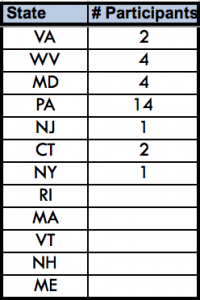 ndowners influenced and acres is rather challenging with our evaluation efforts. While needing to leave out some extreme outlier responses, service providers responses in the post-training evaluation at the end of the 3-day workshop estimated they annually influence 2,027 landowners across the Northeast and approximately 38,800 acres of land. This indicates the potential influence of our educational offerings. 65% of the respondents declared working with forestry type operations and 85% of the total respondents worked specifically with agricultural landowners. Responses estimate that 553 landowners impacted by service providers attending already implement agroforestry practices, with an additional estimated 768 landowners that may be interested in implementing. Additionally, of the 20 responses, 11 participants (58%) assist landowners with implementation funding which could be a big help in influencing landowner implementation. Data is too large for snapshot imaging, please see attached reporting spreadsheet, Sheet 2. “Location and Operation”, for details provided above to determined estimated calculation of landowners and acres influenced.
ndowners influenced and acres is rather challenging with our evaluation efforts. While needing to leave out some extreme outlier responses, service providers responses in the post-training evaluation at the end of the 3-day workshop estimated they annually influence 2,027 landowners across the Northeast and approximately 38,800 acres of land. This indicates the potential influence of our educational offerings. 65% of the respondents declared working with forestry type operations and 85% of the total respondents worked specifically with agricultural landowners. Responses estimate that 553 landowners impacted by service providers attending already implement agroforestry practices, with an additional estimated 768 landowners that may be interested in implementing. Additionally, of the 20 responses, 11 participants (58%) assist landowners with implementation funding which could be a big help in influencing landowner implementation. Data is too large for snapshot imaging, please see attached reporting spreadsheet, Sheet 2. “Location and Operation”, for details provided above to determined estimated calculation of landowners and acres influenced.
This 3 Day Training presented a wealth of information covering the extent of agroforestry systems and their applicability here in the Northeast. Based on the responses reported there was a 57% net gain of knowledge due to this training, with a range of 97% (Agroforestry Resources and Planning Tools) to 29% (Agroforestry Riparian Buffers for Water Quality). This data certainly helps us to consider where there are gaps in knowledge and where our efforts have had the greatest impact. As will be detailed below, this data has influenced our decision to create multiple workshops on Designing Multifunctional Riparian Buffers for Water Quality as well as a Designing Agroforestry Systems. These workshops will be prioritized as additional field day training efforts throughout the Northeast and New England before and after the 2017 3 Day training to help further advance the efforts of the introductory 3 day trainings provided.

Beyond collecting data specific to participant background and knowledge gain, our post training evaluation allowed respondents to provide feedback on the 1.) 3 Things planned to do within 6 months from the training presented 2.) The most significant lessons learned and 3.) any additional feedback to help make our training stronger. The majority of responses detailed participant interest in presenting outreach materials, consultations and/or developing training programs to encourage agroforestry developments to their contacts. It is difficult to find a trend in the most significant lessons learned as respondents replied with a full array related to information gained throughout the entire training. This is important in recognizing that many participants come with a range of knowledge prior to the training and are gaining important components that are relevant to encouraging perennial systems into their professional services. Similarly, the additional feedback present a various array of helpful information to improve future offerings. All responses have been provided in the attached reporting spreadsheet, verbatim to how the participants responded to each question.
On September 21, 2016, the NE SARE grant program administrator joined the planning team on a conference call to offer suggestions as to how to improve on the training design and to facilitate reporting for future workshops and trainings. Among her recommendations:
- Get demographics at registration
- Ask participants to “share one thing” they’d like to learn at the workshop
- Encourage networking by having people partner with someone they don’t know and then introduce them to the group and
- Use round tables that accommodate 4-6 people
- Consult NE SARE “Reading the Farm” manual as template for participants to build case study of farm
The latter recommendation will be included in a June 2017 two-day training focused on agroforestry design applied to existing farmland owned by a conservancy. This conserved land, Lundale Farm http://lundalefarm.org is unique because the land is leased to multiple farmers raising a variety of crops ranging from micro-greens to grass-fed beef. The workshop will be held in cooperation with the Pennsylvania Association for Sustainable Agriculture (PASA) and will allow technical service providers to collaborate with farmers to develop agroforestry plans that can then be integrated into these farming operations. Lundale Farm is located in Chester County, PA, within easy travel from neighboring states.
Plans are under way for the second 3-day training to be held in New York State in partnership with Cornell Cooperative Extension --- by offering the training further north, we hope to capture more participants from New England.
2016Training Evaluation Form_2016
Copy of 2016 Training Evaluation Reporting
9. 80 service providers and 40 farmers attend 4 agroforestry workshops on silvopasturing and forest farming.
Summer 2017
40
80
23
40
September 30, 2017
Completed
March 31, 2019
A total of 87 people participated in the 6 workshops described below. 40 of these individuals self-identified as service providers, 23 as farmers. Other participants did not report their affiliation.
Workshops focused on multi-functionality as a means to enhance agroforestry uptake within both the agricultural and the conservation communities.
Workshop #1
Multi-functional Riparian Forest Buffer Workshop
May 22 and 23, 2017
Extension Building, Chambersburg, PA
What makes multi-functional riparian forest buffers different from other compared with riparian forest buffers? How can a riparian forest buffer help meet the production goals of the farm? How do you ensure riparian forest buffers are retained after CREP contracts are up? What can you harvest from a buffer system? How do you design productive riparian forest buffers that also achieve conservation functions? How do you get new and different landowners interested in riparian forest buffers?
This workshop introduced technical service providers to novel approaches in managed riparian forest buffer systems. The two-day workshop provided perspective on how to plan for economically and agriculturally viable riparian buffer systems that meet landowners’ conservation and production goals. The training dove into key topics like site considerations, management, plant functions, and multifunctional systems to discover suites of management practices and tree and plant designs that achieve new conservation and production goals.
The two day training allowed for the team to employ lessons learned from the previous 3-day training and create an experiential opportunity for attendees to see novel management strategies of riparian systems, learn about design criteria and engage in a networking opportunity through group system design and planning scenarios. Day 1 consisted primarily or presentations and introduction to design considerations for enhanced riparian buffer efficacy. Day two consisted of a visit to a grazed silvopasture riparian buffer to represent alternatives to riparian management. Attendees returned from the field visit with various farm images and operation scenarios to design enhanced riparian management systems. Each group was then able to present to the larger community their plans and receive feedback.
20 participants joined for the training, of which 17 provided post-training evaluations. 2 attendees responded as farmers and 15 as Technical service providers. Of those that responded, 15 Participants were from PA, while 2 joined us from Marylan. TSP Attendees reported a landowner reach of 637 landowners at approximately 44,310 acres, with 60 landowners listed as currently practicing agroforestry systems and potentially 114 known landowners interested.
There was a 36% increase in knowledge provided form this training. With the greatest knowledge gain (42%) being specifically about the opportunity for grazing/silvopasture within the riparian corridor as a real alternative to standard riparian buffer planting. Also most notable is the increase in knowledge pertaining to concentrated by-pass flows and variable width concepts. These are supported by the USDA National Agroforestry Center’s research into successful riparian buffers but have not yet been accepted by the USDA standards for riparian buffer implementation within conservation incentive payment programs. Attendees from both NRCS, extension, conservation districts and NGO’s working specifically within the riparian management programs were made aware of the new science surround not only alternative management of riparian buffers but the importance of site explicit design. Such alternative may make implementation of agroforestry and riparian buffers in general more effective across the various agricultural community.
Multi-functional Riparian Forest Buffer Training
September 14 and 15, 2017
Wellsboro, PA
This workshop introduced technical service providers to novel approaches in managed riparian forest buffer systems. The two-day workshop provided perspective on how to plan for economically and agriculturally viable riparian buffer systems that meet landowners’ conservation and production goals. The training dove into key topics like site considerations, management, plant functions, and multi-functional systems to discover suites of management practices and tree and plant designs that achieve new conservation and production goals. Similar to the Chambursburg PA training in May of 2017, this training was altered slightly based on previous feedback as well as catered to more regionally specific buffer interests and opportunities.
The two day training allowed for the team to employ lessons learned from the previous 3-day training and create an experiential opportunity for attendees to see novel management strategies of riparian systems, learn about design criteria and engage in a networking opportunity through group system design and planning scenarios. Day 1 consisted primarily or presentations and introduction to design considerations for enhanced riparian buffer efficacy. Day two consisted of a visit to two riparian buffers, both with challenges and to represent alternatives to riparian management. Attendees returned from the field visit with various farm images and operation scenarios to design enhanced riparian management systems. Each group was then able to present to the larger community their plans and receive feedback.
9 participants joined for the training, of which 7 provided post-training evaluations, of which all reported themselves as technical service providers. Of those that responded, 4 Participants were from PA, 1 from Connecticut, while 2 joined us from Vermont. TSP Attendees reported a landowner reach of 111 landowners at approximately 13,300 acres, only 24 landowners listed as currently practicing agroforestry systems and potentially 8 known landowners interested.
There was a 48% increase in knowledge provided form this training. With the greatest knowledge gain (63%) being specifically about the opportunity for agroforestry systems within the riparian corridor as a real alternative to standard riparian buffer planting. Also most notable is the increase in knowledge pertaining to concentrated by-pass flows (50%) and site explicit design for enhanced riparian efficacy (59%). These are supported by the USDA National Agroforestry Center’s research into successful riparian buffers but have not yet been accepted by the USDA standards for riparian buffer implementation within conservation incentive payment programs. Attendees from both NRCS, extension, conservation districts and NGO’s working specifically within the riparian management programs were made aware of the new science surround not only alternative management of riparian buffers but the importance of site explicit design. Such alternative may make implementation of agroforestry and riparian buffers in general more effective across the various agricultural communities. Unfortunately, were unable to find a well managed grazed riparian buffer site in northern PA. However, during this training Kimberly Hagen, grazing specialist for Vermont’s Center for Sustainable Agriculture presented on grazing for vegetative management and research she has been doing documenting grazed riparian corridors. Though a field site was not available, this led to a 42% increase in awareness that grazing could be used as a riparian management tool.
Workshop #3
Designing Agroforestry Practices on the Farm: A Case Study in Forest Farming Riparian Buffers
November 15th, 2017
Natural Hope Herbals – Millersburg, PA
This was a unique day-long experiential training on forest farming multifunctional riparian buffers for enhanced natural resource stewardship and economic viability. Natural Hope Herbals LLC is an Amish owned family farm and company that seeks to further develop their on-farm medicinal plant production practices and areas using agroforestry approaches. For this event, we utilized this site and value-added operation to provide an exciting case study to discuss how land stewardship, agroforestry farm systems and value-added processing can be integrated successfully through appropriate design and implementation. Presenters Eric Burkhart and Erik Hagan walked attendees through a process of determining site value and ecological function while connecting ecosystem management to an established value-added herbal medicinal business through the production of forest grown herbs and riparian fruit and nut species. This highly engaging and interactive design session provided participants with a real-world consulting and designing scenario. Part of the NE SARE Agroforestry Professional Development Training series, this event provided technical service providers, researchers and producers with instruction and conversation around agroforestry production system design in the Northeast/Mid-Atlantic region.
11 participants joined for the training, of which 6 provided post-training evaluations. 3 attendees responded as farmers and 3 as Technical service providers. Of those that responded, 5 Participants were from PA, while 1 joined us from Maine. TSP Attendees reported a landowner reach of 52 landowners at approximately 2,432 acres, with 12 landowners listed as currently practicing agroforestry systems and potentially 37 known landowners interested.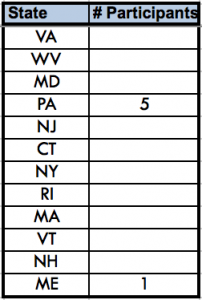
There was a 51% increase in knowledge provided form this training. With the greatest knowledge gain (69%) being around the opportunity for forest farming within existing riparian forest buffers and the importance for site explicit design (64%). Also notable is a 50% increase in knowledge of agroforestry opportunities for uplands and slopes as they relate to riparian buffer systems.
Workshop #4
Designing Multi-functional Agroforestry Systems Training
June 6th – 7th, 2017
Lundale Farm Pottstown, PA
Agroforestry, the intentional planting or management of perennial tree and shrub species within an agricultural system, can provide a multi-functional approach for enhancing land stewardship, meeting conservation goals and increasing and diversifying income potential. Well-informed placement and management of these long-term systems is paramount for achieving success and maximizing returns on investment. On June 5th – 6th NEMA partnered with the Pennsylvania Association for Sustainable Agriculture to host a two day, hands-on design intensive where we introduce concepts of agroforestry systems and walk attendees through the process of accessing the landscape for opportunities for incorporating perennial agricultural systems into an already actively managed farm. This training was intended to mix landowner/operators with professional service providers to encourage a dynamic group learning process through experience sharing, reality checking and innovative idea generating conversations.
This event took place on Lundale Farm, a 520-acre preserved landscape of woodlands, pastures, crop fields and riparian areas, bordered by French Creek and Beaver Run. Currently, there are six agricultural operations on Lundale property, producing a wide range of products, from pastured poultry to microgreens, to vegetables and beef. The diversity of the landscape and farming operations on Lundale’s property made it an ideal location for hosting this workshop intended on helping land stewards realize the greatest regenerative, productive potential of their managed landscapes. Erik Hagan gave some detailed design framework for considering trees in the agricultural landscape for multiple benefits; Kate MacFarland (USDA NAC) presented agroforestry systems role in landscape multi-functionality; Tracey Coulter (PADCNR) presented on water quality and riparian buffer opportunities, Eric Burkhart (PSU) discussed and led attendees on a forest and edge-of forest walk to discuss opportunities in edge management and forest farming; and Peter Hoagland (USDA NRCS) presented on a NRCS implementation funding opportunities and programs. Day 2 was comprised of a full farm walk, visiting the individual farm enterprises that are part of the design practicum portion of the training. Groups were then presented their scenario and enterprise and spent the day with the individual farmer, to discuss opportunities, challenges, barriers, etc. The workshop concluded in the groups presenting to the farmers their proposed perennial system additions to the various operations and receiving feedback directly from the producers. Particularly exciting thing concerning this training was not only the vast resource that the site provided but the partnership with PASA in hosting the event. The intention here was to trigger a more lasting partnership with a highly active and engaged community of practitioners, educators, researchers etc. in the world of sustainable agriculture. We plan to continue developing this relationship and have already successfully presented a number of events and presentations at their annual conferences.
25 participants joined for the training, of which 18 provided post-training evaluations, of which 7 reported themselves as farmer and 11 as technical service providers. Of those that responded, 17 participants were from PA, 1 from Ohio. TSP Attendees reported a landowner reach of 2,027 landowners at approximately 38,800 acres, only 567 landowners listed as currently practicing agroforestry systems and potentially 847 known landowners interested.
There was a 51% increase in knowledge provided form this training. With the greatest knowledge gain (61%) being specifically about site explicit design considerations, 59% increase on the multi-functional opportunities within agroforestry systems and 58% increase in understanding of agroforestry systems for upland sites and hillsides. Due to the very diverse nature of the site, ecologically/geologically, as well as the diversity of agricultural enterprises, this training gave a wealth of experiential opportunities to better understand the role of trees amongst various agricultural systems and the placement and appropriateness of these systems for achieving production and conservation goals simultaneously.
Workshop #5
Designing Agroforestry Practices on the Farm: A Case Study in Forest Farming Riparian Buffers
November 15th, 2017
Natural Hope Herbals – Millersburg, PA
This was a unique day-long experiential training on forest farming multifunctional riparian buffers for enhanced natural resource stewardship and economic viability. Natural Hope Herbals LLC is an Amish owned family farm and company that seeks to further develop their on-farm medicinal plant production practices and areas using agroforestry approaches. For this event, we utilized this site and value-added operation to provide an exciting case study to discuss how land stewardship, agroforestry farm systems and value-added processing can be integrated successfully through appropriate design and implementation. Presenters Eric Burkhart and Erik Hagan walked attendees through a process of determining site value and ecological function while connecting ecosystem management to an established value-added herbal medicinal business through the production of forest grown herbs and riparian fruit and nut species. This highly engaging and interactive design session provided participants with a real-world consulting and designing scenario. Part of the NE SARE Agroforestry Professional Development Training series, this event provided technical service providers, researchers and producers with instruction and conversation around agroforestry production system design in the Northeast/Mid-Atlantic region.
11 participants joined for the training, of which 6 provided post-training evaluations. 3 attendees responded as farmers and 3 as Technical service providers. Of those that responded, 5 Participants were from PA, while 1 joined us from Maine.
TSP Attendees reported a landowner reach of 52 landowners at approximately 2,432 acres, with 12 landowners listed as currently practicing agroforestry systems and potentially 37 known landowners interested.
There was a 51% increase in knowledge provided form this training. With the greatest knowledge gain (69%) being around the opportunity for forest farming within existing riparian forest buffers and the importance for site explicit design (64%). Also notable is a 50% increase in knowledge of agroforestry opportunities for uplands and slopes as they relate to riparian buffer systems.
Workshop #6
Multi-functional Hedgerows Training
Friday March 29th, 2019
Windswept Agroforestry Farm – State College, PA
Hedgerow systems provide opportunities to improve soil and water quality higher in the landscape while creating beneficial habitat for wildlife and pollinators and altering site climatic conditions to enhance farm productivity. In some cases, hedgerows may be used as upland buffers to reduce sediment and nutrient runoff potential at its source. While providing all of these potential benefits, hedgerows also provide opportunities for fruit and nut production and additional diversity of livestock fodder. Pending site context, various forms of hedgerows may have the highest potential for site diversification and conservation outcomes. But how do all these multifunctional components fit together, and especially, how are they installed, maintained and how can this improve farm operation efficiency?
As part of the a NESARE Professional Development Program grant this training provided professionals working in the agriculture and natural resources management fields an opportunity to experience and understand opportunities provided in developing hedgerow systems and how to maximize the use of them. Training took place at Windswept Agroforestry Farm, a highly diverse operation, utilizing NRCS EQIP programs to install a new hedgerow-structured rotational grazing system to enhance conservation outcomes for habitat and soil/water quality on a currently open pasture. This training provided insight into historic hedgerow systems, installation and management techniques, species selection, conservation funding opportunities and designing for multi-functionality. The day was comprised of lectures, discussion, field tour and design practicum, catered lunch fresh from the farm and an optional tour of additional agroforestry developments at Windswept Agroforestry Farm was provided. Lecturers included Meghan Giroux from Vermont Edible Landscaping and Interlace Agroforestry farm on the historical context, design and management of hedgerows in grazing landscapes; Erik Hagan, farm manager of Windswept Agroforestry Farm, provided background on the site, design considerations and tour of the operation, Jim Gillis, PA State Biologist for the USDA Natural Resource Conservation Service presented on pollinator habitat in hedgerows systems and Scott Heckman, District Conservation from the USDA Natural Resource Conservation Service presented on the site specific funding developments provided through the NRCS EQIP program for Windswept Farm as well as on general agroforestry specific funding opportunities through NRCS conservation programs. Full Agenda is attached.
11 participants joined for the training, of which 5 provided post-training evaluations. 3 attendees responded as farmers and Technical service providers, while the other respondents represented a service provider background. Of those that responded, 4 Participants were from PA, while 1 was from New York. TSP Attendees reported a landowner reach of 275 landowners at approximately 3,590 acres, with 65 landowners listed as currently practicing agroforestry systems and potentially 50 known landowners interested. 80% of the TSP’s stated they assist landowners in with implementation funding for land management projects.
There was a 23% increase in knowledge provided form this training. With the greatest knowledge gain (29%) being around upland buffer opportunities (water/air quality) and the concept of multi-functional landscape features (hedgerows creating multiple benefits in the landscape).
This training was a great success, thanks largely to NRCS representatives and Meghan Giroux for her expertise and research on hedgerow systems in agricultural landscapes.
11. 50 service providers respond to invitation and 30 are confirmed for 3 day training, enroll in community of practice and core training program and commit to participating in 3-day comprehensive training workshops.
March 2017
12. 30 service providers attend 3 day training that will prepare them to advise farmers on the benefits and opportunities of implementing agroforestry practices on their farms and woodlots. Participants will complete pre-program knowledge surveys. Participants also complete post-training survey to identify future training needs and to measure knowledge acquired.
Summer 2017
30
8
30
September 30, 2017
Completed
October 19, 2017
October 17-19th marked the second 3-Day Agroforestry Professional Development Training through the NESARE PDP Grant at the Schuyler County Cornell Cooperative Extension office and conference room in Montour Falls, NY. This 3 day event consisted of 2 days of presentations, a full day of tours and an evening networking at the Finger Lakes Cider House at Good Life Farm who employs agroforestry practices for the production of products for the cider house. Presentations ranged from agroforestry specific practices (silvopasture, hedgerows, alley cropping, forest farming) to planning and funding resources and tools. Kate MacFarland from the USDA National Agroforestry Center, Steve Gabriel and Brett Chedzoy from Cornell Cooperative Extension, Joe Orefice from Yale School of Forestry and Erik Hagan from Penn State led the presentations on the first and third day. The second day was comprised of site visits to Cornell’s Arnot forest for an opportunity to see a large scale Maple Syrup operation and novel technologies applied, forest management for maple syrup production as well as site assessment considerations for wild simulated ginseng production. Wellspring Forest Farm and School was the second stop for looking into outdoor shiitake mushroom log production, small scale maple syrup and sheep silvopasture. Next was Brett Chedzoy’s Angus Glen farm for larger scale silvopasture and woodlot restoration and management using cattle silvopasture. Twisted Tree Nursery gave attendees insight into tree crop nursery production as well as various nut planting and considerations for local nut aggregation cooperatives. Finally the day concluded with a tour of Good Life Farm for looking into alley cropping and turkey silvopasture within a highly productive cider fruit orchard produced for the on-site Finger Lakes Cider House. Complete agenda is attached.
A total of 35 registered participants from the Northeast/Mid-Atlantic region joined us for the event. Out of the 35 attendees 30 participants filled out the post training evaluation form. Many attendees play multiple technical service provider roles ranging from forestry consultants to agricultural educators.12 participants, or 40% of the total respondent group replied as farmer/landowner while 29, or 97% of respondents listed themselves as some sort of technical service providers. This data is highlighted in the table below
The respondents also highlighted their geographic range of professional impact, highlighted in the table below, with the majority of participants from from New York State (16) though with representation from the greater Northeast. We selected this region of upstate New York for this second 3-Day training event based on feedback from the NEMA network, as well as proximity to New England and the optimal, most mature cluster of various forms of Agroforestry sites for the field tour portion of the training. The hope was to garner more participants from the New England region that participated, however, we were excited to have drawn participants from states that we had no prior connection to within the agroforestry community.
Based on the data collected through the post training evaluation, respondents reported working with an estimated 1,732 landowners across the Northeast who manage approximately 78,130 acres of land, indicating the potential for service providers to extend the influence of these educational offerings. 143 of these landowners were represented as already practicing agroforestry systems, while 365 landowners were estimated to have interest to implement these systems in the near term. 31% of the respondents declared working with forestry type operations and 69% of the total respondents worked specifically with agricultural landowners. Additionally, of the 30 responses, 13 participants (43%) assist landowners with implementation funding which could be a big help in influencing landowner implementation. For full reporting see the attached document: “2017 NY PDP” reporting spreadsheet (Sheet 2 – Location and Operation).
This 3 Day Training presented a wealth of information covering the extent of agroforestry systems and their applicability here in the Northeast. Based on the responses reported there was a 47% net gain of knowledge due to this training, with a range of 74% (Agroforestry Resources and Planning Tools) to 29% (Agroforestry Riparian Buffers for Water Quality). This data certainly helps us to consider where there are gaps in knowledge and where our efforts have had the greatest impact. As described in the 2016 Pennsylvania PDP training, this data has influenced our decision to create multiple workshops on Designing Multifunctional Riparian Buffers for Water Quality as well as a Designing Agroforestry Systems, which will be reported within this final report where see further increases in knowledge gained on those specific topics.
Based on the data collected through the post training evaluation we were able to estimate an annual influence of 1,732 landowners across the Northeast and approximately 78,130 acres of land influenced through this educational offerings. 143 of these landowners were represented as already practicing agroforestry systems, while 365 landowners were estimated to implement these systems in the near term. 31% of the respondents declared working with forestry type operations and 69% of the total respondents worked specifically with agricultural landowners.
Additionally, of the 30 responses, 13 participants (43%) assist landowners with implementation funding which could be a big help in influencing landowner implementation. For full reporting see the attached document: “2017 NY PDP” reporting spreadsheet (Sheet 2 – Location and Operation).
This 3 Day Training presented a wealth of information covering the extent of agroforestry systems and their applicability here in the Northeast. Based on the responses reported there was a 47% net gain of knowledge due to this training, with a range of 74% (Agroforestry Resources and Planning Tools) to 29% (Agroforestry Riparian Buffers for Water Quality). This data certainly helps us to consider where there are gaps in knowledge and where our efforts have had the greatest impact. As described in the 2016 Penssylvania PDP training, this data has influenced our decision to create multiple workshops on Designing Multifunctional Riparian Buffers for Water Quality as well as a Designing Agroforestry Systems, which will be reported within this final report where see further increases in knowledge gained on those specific topics.
This training was highly success, with a majority of the attendees now engaged within the NEMA Agroforestry Network and hosting their own agroforestry specific trainings.
13. 40 service providers respond to participant follow-up survey and complete and return verification surveys to report on completed and planned educational and outreach programs and stakeholder adoption of agroforestry practices as a result of these efforts. Project team completes evaluation and report.
40
May 31, 2018
In Progress
The project team was unable to complete the follow-up verification survey due to changes in the professional situations of personnel.
Milestone Activities and Participation Summary
Educational activities and events conducted by the project team:
Participants in the project’s educational activities:
Learning Outcomes
See milestone reports for summaries about areas of knowledge gain as a result of the project's educational programs.
Performance Target Outcomes
Performance Target Outcomes - Service Providers
Target #1
40
40 Northeast service providers who receive comprehensive agroforestry training will provide agroforestry assistance to 120 farmers and graziers who manage 3,600 acres of woodlot.
120
3,600 acres of woodlot
The project team was unable to conduct a final follow-up survey to verify specific reports of service providers using knowledge and skills learned through the project with specific numbers of farmers. We have strong evidence from post-workshop, post-training and post-webinar surveys that the training received was effective at increasing knowledge (see reports of post-event survey results in milestones) and highly valued by participants (see quotes in success stories section), of whom 285 were service providers. These service providers reported they worked with an estimated 3,619 landowners, many of whom are farmers, who manage an estimated 239,940 acres. Further, they reported that and estimated 1,425 of the landowners they work with are already practicing one or more agroforestry practices and 2,194 have interest in these practices. This data provides a strong indication that the potential is high that this program has had influence on decisions by farmers and other forest landowners advised by project participants.
Additional Project Outcomes
Three additional grants were awarded that were directly related to this NESARE funded project. Two of the three were related to seeking chestnut aggregation and cooperative development through the NESARE Farmer Grant and the PA Specialty Crop Block Program. The third grant is related to silvopasture developments in new england that have been direct cooperators within the administration of this funded project.
In addition, the educational opportunities provided in the grant enhanced the outreach and application of multi-functional buffer program administered by the PA Department of Conservation and Natural resources program. Thus, further enhancing agroforestry systems to meet state and regional conservation outcomes capturing state and federal dollars for further educational opportunities and implementation. Numerous projects are being influenced and administered by project coordinators, cooperators and beneficiaries.
A key outcome of the project was the development of NEMA (North-East Mid-Atlantic Agroforestry Working Group). This group is comprised of members located throughout the NE through to Virginia. Representatives of this group met in Acra, NY in September of 2018 to consider next steps following the conclusion of this project::
- Increase/support expanding NEMA “membership” (membership means simply engaging in the various activities below): If people ask to get involved, share that we are a network of active agroforestry professionals and practitioners in the Northeast and Mid-Atlantic States – join in if you are working with agroforestry in any capacity by:
- Attending webinars on agroforestry topics: http://www.nemaagroforestry.org/webinars/
- Joining quarterly calls to share our work: These are hosted by Cornell Agroforestry team - next one in Jan 2019
- Signing up for the monthly email update at http://www.nemaagroforestry.org/contact/ or bit.ly/NEMAupdate
- Viewing or joining the open directory of contacts in the network: https://tinyurl.com/NEMADirectory
- Continue monthly NEMA Update
- Continue emails. Submit news, events, opportunities, and resources for this monthly update to: Kate MacFarland: [email protected]
- Encourage new people to sign up through the NEMA homepage or bit.ly/NEMAsignup
- Hold quarterly phone calls (January/March/May/October) to allow NEMA members to update one another on activities
- Enhance NEMA website
- Continue social media efforts
- Continue webinars
- Reach out about and plan new workshops:
- Share information about upcoming trainings with the larger group and for the NEMA update
- Try for one 3 day training in 2020
Comments from Some Participants of NE SARE ENE15-134- Funded Workshops
It was always a pleasure to attend NE SARE Agroforestry Training workshop. I found that the workshops provided a lot of the large picture infrastructure considerations that are necessary when designing or implementing agroforestry practices. All of the presenters had extensive knowledge and were very happy to share information. It was always a treat to be in a group of passionate, environmentally considerate people. In the future, I would enjoy more site visits like Ant Hill Farm and Wind Swept Farm. The overall picture of operations that they provided were invaluable. Thank you for making this opportunity happen.
Landscape Designer & Arboriculture Consultant _____________________________________________________________________________
Agroforestry is an integral part of a resilient, diversified and sustainable farming enterprise, and as an advocate and educator for resilient farming and land management, the NE SARE Agroforestry Project Team are an invaluable resource. Their work to demystify the principles of agroforestry through simple explanations and fun, interactive, hands-on demonstrations is both inspiring and practical. By collaborating with other agriculturally-focused organizations around the group is spreading the message through a diverse and effective range of networks, both professional and personal. I was fortunate enough to attend a NE SARE – sponsored field day at Windswept Farm in central PA highlighting the importance and uses of windbreaks and hedgerows. Beyond these informative and enjoyable experiences, I know I can turn to this agroforestry network when I need to expand my own knowledge of the detailed workings of a healthy agroforestry system, which I can then pass on to my own network. I fully support and applaud NE SARE for supporting this agroforestry work, and I fervently hope they will be able to continue to expand their reach and engagement with ever more audiences!
Farmer and Pennsylvania Women's Agricultural Network Regional Coordinator
______________________________________________________________________________
I am deeply grateful for the opportunities that have been unlocked for me through the NE SARE-funded agroforestry educational events. I very much doubt I would be at the place I am today- running a successful business helping landowners strategically add trees to their farms, to the tune of thousands per year- had it not been for the connections created through the NEMA Agroforestry group through the funding they received.
In Fall 2016 I was just starting to take online courses in agroforestry, but had no local contacts or field experience. Attending an educational event that Fall got me in the door and connected to countless professionals. It was from there, that I was able to discover where there were unmet needs in the conservation field, namely for someone to provide the service of follow-up care to streamside forest plantings. I figured I could start by doing that, and have since grown to offer tree planting and consultation, while being very aware of the tremendous opportunities for productive conservation that still await.
Streamside buffer and farmland management consultant
______________________________________________________________________________
We benefitted greatly from the NE SARE PDP trainings and networking opportunities in which we participated. The timing and content of the two-day workshop at Lundale Farm was particularly valuable. We got to meet multiple people from whom we have since received valuable advice and guidance as we have planned, found funding for, and begun the planting of over 26 acres of diverse agroforestry systems on our farm.
Executive Director, Center for Agricultural Education
One of the biggest successes of the project was the development of the Northeast Mid-Atlantic Agroforestry Network. What started as the advisory board for the NESARE and born out of the Association for Temperate Agroforestry working groups, has become a region-wide network of technical service providers, researchers educators and practitioners convening around support for the development of agoforestry systems in the northeast and mid-Atlantic regions. Continued quarterly calls, website and social media presence and continued webinar series are all tangible outcomes of this project. This networks is currently seeking to implement non-profit status in order to administer their own funding resources and programmatic activities through collaborative outreach and educational opportunities across state and institutional boundaries.
This project spurred regional discussion and recognition of agroforestry. In Pennsylvania, one county received a State-funded grant to develop an agroforestry education program, including the establishment of a multifunctional riparian forest buffer to demonstrate the value of productive conservation practices. A state-level agroforestry team (PA Agroforestry Brain Trust) comprised of technical service providers, agency staffs and farmers was convened to address the knowledge, market and infrastructure gaps identified through this project.
